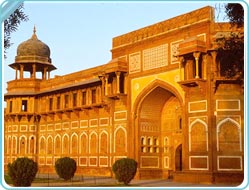
Ever since Babur defeated and killed Ibrahin Lodi at Panipat in
1526, Agra played an important center of Mughal Empire. Akbar chose this city on
the bank of River Yamuna as his capital and proceeded to build a strong citadel
for the purpose. It is said that he destroyed the damaged old fort of Agra for the
purpose and raised this grand group of monuments instead in red sandstone. Started
in 1565, it took eight years and thirty-five lakh rupees to complete its construction
and is second only to Taj in Agra. Qasim Khan Mir Barr-u-Bahr supervised the construction
of this building.
One of the large fortified residences built at various strategic points of Mughal
Empire; it had over five hundred buildings, as mentioned by Abul Fazal in his chronicles.
Most of the buildings added later use marble as the chief construction material.
At the time of Akbar, River Yamuna touched the fort and thus, a number of ghats
were built here. Some of these ghats were meant to load and unload goods transported
through river and other covered passages were for use by the harem inmates only.
The Agra Fort was begun by Akbar between 1565 and 1573. It is situated on the west
bank of the Jumna River, about 2km upstream from the Taj Mahal (map).
Akbar built the fort of sandstone; his grandson Shah Jahan, the builder of the Taj
Mahal, constructed palaces of white marble within the fort itself. Shah Jahan was
imprisoned in Agra Fort following the coup of his son, Aurangzeb, and died here
in 16571.
Agra Fort is entered today at the south end, through a low outer wall and gate (shown
here) built by Aurangzeb. Visitors then pass in succession through two of Akbar's
gates, the Amar Singh and the Akbari, before finally gaining admittance to the fort
proper. The original entrance to the fort was through the grander Delhi Gate in
the west wall.
1The behavior of Mogul rulers, towards members of their own family,
was appalling by any humane standard. Besides overthrowing and imprisoning his father,
Aurangzeb murdered two brothers and a nephew on his way to the throne; his father,
Shah Jahan, had similarly killed one brother and two nephews
during his own climb
to power. It wasn't because they were "bad" people (at least, not by their own standards,
however much we moderns may deplore their evil deeds); in that time there were no
fixed laws of succession, and the harem system provided all too many candidates
for the throne; it was, literally, kill or be killed for eligible males of the royal
family. History shows an astonishing number of such deplorable examples, from ancient
China all the way across to the Roman and Byzantine Empires, ancient Egypt, the
Ottoman Empire, and, at times, even Medieval and Renaissance Europe.

